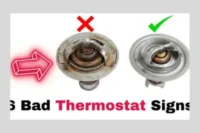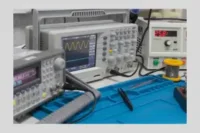Top Signs of a Bad Engine Thermostat and How to Fix Them
Published: 29 Mar 2025
Your engine’s thermostat might be a small and seemingly insignificant component, but it plays a crucial role in maintaining optimal operating temperatures for your vehicle. If your thermostat goes bad, it can lead to a range of problems, from decreased fuel efficiency to engine overheating. In this article, we’ll discuss the top signs of a faulty engine thermostat and provide you with steps on how to fix them.

Signs of a Bad Engine Thermostat:
- Temperature Fluctuations: One of the most common signs of a bad thermostat is erratic temperature readings on your dashboard gauge. If you notice that the temperature gauge moves from normal to hot quickly or fluctuates unexpectedly, it’s a clear indication that your thermostat may be malfunctioning.
- Engine Overheating: An engine running hotter than usual is a red flag. If your temperature gauge shows a consistently high reading, it could be due to a thermostat that’s stuck closed, preventing coolant flow and causing your engine to overheat.
- Poor Fuel Efficiency: A faulty thermostat can lead to inefficient fuel usage. When the thermostat fails to open properly, the engine remains in a “cold” state for too long, causing it to run rich. This can result in decreased fuel economy, which is bad for your wallet and the environment.
- Heater Issues: If your vehicle’s interior heater isn’t providing sufficient warmth or takes a long time to warm up, it could be related to a malfunctioning thermostat. A properly functioning thermostat regulates coolant flow to the heater core, allowing it to provide warm air to the cabin.
- Low Coolant Levels: A failing thermostat can cause coolant to get trapped in the engine, leading to low coolant levels in the radiator. If you frequently find yourself needing to top up the coolant, it’s a sign that something is amiss.
| Ecobee Thermostat |
|---|
 Please Note Limit 1 thermostat per customer (life of the program) Warranty 3 Year Limit Maintenance Alerts and Reminders Yes Learns Habits Over Time No Adjustable Schedule Yes Wi-Fi Enabled and Remote Access Yes Energy Usage Reports Yes Activity and Motion Sensors Yes Built-in Voice Control Yes Geofencing Yes Remote Sensor Sold Separately |
How to Fix a Bad Engine Thermostat:
- Diagnostic Check: Before you start replacing parts, it’s essential to confirm that the thermostat is indeed the issue. A professional diagnostic check, often involving a scan tool, can help pinpoint the problem. This step is crucial to avoid unnecessary repairs.
- Thermostat Replacement: If the thermostat is indeed the culprit, it’s time to replace it. Locate the thermostat housing (usually near the engine block), drain some coolant, remove the housing, and carefully replace the thermostat. Ensure you follow the manufacturer’s guidelines and use the correct thermostat for your vehicle.
- Coolant System Flush: During the replacement of the thermostat, consider performing a coolant system flush. This helps remove any debris or contaminants that might have accumulated due to the thermostat’s malfunction.
- Regular Maintenance: To prevent future thermostat issues, follow your vehicle’s maintenance schedule. Regularly check the coolant levels, inspect the thermostat housing for leaks, and ensure your cooling system is in good condition.
A bad engine thermostat can lead to a range of problems that affect your vehicle’s performance and efficiency. By recognizing the signs of a failing thermostat and taking prompt action to fix the issue, you can prevent more extensive damage and keep your engine running smoothly. Regular maintenance and attention to your vehicle’s cooling system are essential for the longevity of your car and your driving comfort.
A smart thermostat is a device that controls your home’s heating and cooling system through an app or voice commands, offering energy efficiency, remote control, and personalized settings.
Smart thermostats adjust temperatures based on your habits, learning your preferences, and optimizing settings, which can reduce energy consumption and lower utility bills by preventing heating or cooling wastage.





